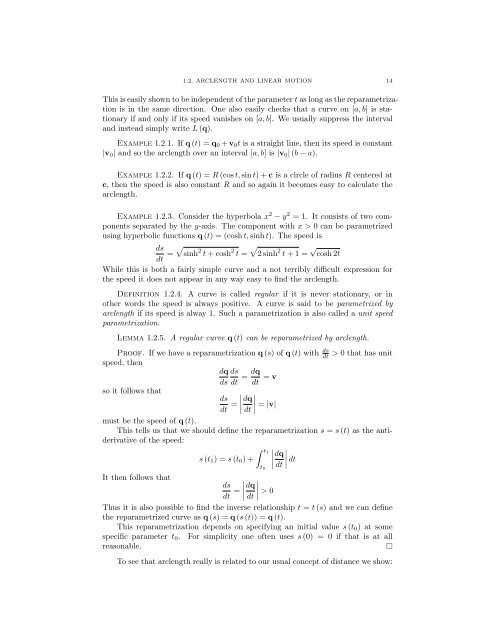Lecture Notes for 120 - UCLA Department of Mathematics
Lecture Notes for 120 - UCLA Department of Mathematics
Lecture Notes for 120 - UCLA Department of Mathematics
Create successful ePaper yourself
Turn your PDF publications into a flip-book with our unique Google optimized e-Paper software.
1.2. ARCLENGTH AND LINEAR MOTION 14<br />
This is easily shown to be independent <strong>of</strong> the parameter t as long as the reparametrization<br />
is in the same direction. One also easily checks that a curve on [a, b] is stationary<br />
if and only if its speed vanishes on [a, b]. Weusuallysuppresstheinterval<br />
and instead simply write L (q).<br />
Example 1.2.1. If q (t) =q 0 + v 0 t is a straight line, then its speed is constant<br />
|v 0 | and so the arclength over an interval [a, b] is |v 0 | (b a).<br />
Example 1.2.2. If q (t) =R (cos t, sin t)+c is a circle <strong>of</strong> radius R centered at<br />
c, thenthespeedisalsoconstantR and so again it becomes easy to calculate the<br />
arclength.<br />
Example 1.2.3. Consider the hyperbola x 2 y 2 =1. It consists <strong>of</strong> two components<br />
separated by the y-axis. The component with x>0 can be parametrized<br />
using hyperbolic functions q (t) = (cosh t, sinh t). The speed is<br />
ds p<br />
p<br />
dt = sinh 2 t + cosh 2 t = 2sinh 2 t +1= p cosh 2t<br />
While this is both a fairly simple curve and a not terribly difficult expression <strong>for</strong><br />
the speed it does not appear in any way easy to find the arclength.<br />
Definition 1.2.4. Acurveiscalledregular if it is never stationary, or in<br />
other words the speed is always positive. A curve is said to be parametrized by<br />
arclength if its speed is alway 1. Suchaparametrizationisalsocalledaunit speed<br />
parametrization.<br />
Lemma 1.2.5. A regular curve q (t) can be reparametrized by arclength.<br />
Pro<strong>of</strong>. If we have a reparametrization q (s) <strong>of</strong> q (t) with ds<br />
dt<br />
> 0 that has unit<br />
speed, then<br />
dq ds<br />
ds dt = dq<br />
dt = v<br />
so it follows that<br />
ds<br />
dt = dq = |v|<br />
dt<br />
must be the speed <strong>of</strong> q (t).<br />
This tells us that we should define the reparametrization s = s (t) as the antiderivative<br />
<strong>of</strong> the speed:<br />
ˆ t1<br />
dq<br />
s (t 1 )=s (t 0 )+ dt<br />
t 0<br />
dt<br />
It then follows that<br />
ds<br />
dt = dq > 0<br />
dt<br />
Thus it is also possible to find the inverse relationship t = t (s) and we can define<br />
the reparametrized curve as q (s) =q (s (t)) = q (t).<br />
This reparametrization depends on specifying an initial value s (t 0 ) at some<br />
specific parameter t 0 . For simplicity one <strong>of</strong>ten uses s (0) = 0 if that is at all<br />
reasonable.<br />
⇤<br />
To see that arclength really is related to our usual concept <strong>of</strong> distance we show:
















